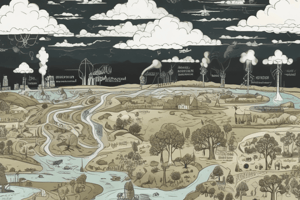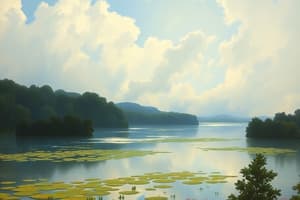Podcast
Questions and Answers
What is the key concept of Unit 1 in Ecology Science 9?
What is the key concept of Unit 1 in Ecology Science 9?
- Globalization
- Interactions
- Consequences
- Systems (correct)
Which of the following is NOT one of the 4 essential biogeochemical cycles mentioned in the text?
Which of the following is NOT one of the 4 essential biogeochemical cycles mentioned in the text?
- Phosphorus cycle
- Oxygen cycle (correct)
- Carbon cycle
- Nitrogen cycle
What is the main role of bacteria and decomposers in the biogeochemical cycles?
What is the main role of bacteria and decomposers in the biogeochemical cycles?
- Producing raw elements
- Transforming raw elements into energy
- Absorbing raw elements
- Breaking down dead organisms into raw elements (correct)
Which biogeochemical cycle involves the movement of water between different reservoirs?
Which biogeochemical cycle involves the movement of water between different reservoirs?
Why is it important for materials to change states and transform in biogeochemical cycles?
Why is it important for materials to change states and transform in biogeochemical cycles?
Which concept is NOT directly related to the biogeochemical cycles mentioned in the text?
Which concept is NOT directly related to the biogeochemical cycles mentioned in the text?
What is the term used to describe the process of liquid water transforming into water vapor in the atmosphere?
What is the term used to describe the process of liquid water transforming into water vapor in the atmosphere?
During which time of the day do evaporation and transpiration mainly occur?
During which time of the day do evaporation and transpiration mainly occur?
When water droplets in clouds become large enough, what process results in them falling to the earth?
When water droplets in clouds become large enough, what process results in them falling to the earth?
Which process involves surface water flowing on land and eventually returning to an ocean or lake?
Which process involves surface water flowing on land and eventually returning to an ocean or lake?
In the carbon cycle, which organisms use carbon dioxide from the air or water as a raw material to build organic molecules?
In the carbon cycle, which organisms use carbon dioxide from the air or water as a raw material to build organic molecules?
What is the term for the process by which water is absorbed by plants through their roots?
What is the term for the process by which water is absorbed by plants through their roots?
What is the role of nitrifying bacteria in the nitrogen cycle?
What is the role of nitrifying bacteria in the nitrogen cycle?
How do plants utilize nitrates and nitrites?
How do plants utilize nitrates and nitrites?
What is the process of assimilation in relation to nitrogen?
What is the process of assimilation in relation to nitrogen?
Which process involves the conversion of nitrate to nitrogen gas?
Which process involves the conversion of nitrate to nitrogen gas?
What is the significance of phosphorus in ecosystems?
What is the significance of phosphorus in ecosystems?
How does phosphorus primarily enter the soil or water in the phosphorus cycle?
How does phosphorus primarily enter the soil or water in the phosphorus cycle?
What is one way carbon can return to the atmosphere?
What is one way carbon can return to the atmosphere?
Which process releases CO2 into the air during volcanic eruptions?
Which process releases CO2 into the air during volcanic eruptions?
What happens when dissolved CO2 in water exceeds its saturation point?
What happens when dissolved CO2 in water exceeds its saturation point?
Which process leads to the formation of solid limestone?
Which process leads to the formation of solid limestone?
What is a consequence of too much dissolved CO2 in water?
What is a consequence of too much dissolved CO2 in water?
How does carbon enter the hydrosphere or geosphere through burial?
How does carbon enter the hydrosphere or geosphere through burial?
What happens to dead organisms under conditions where decomposers cannot break them down?
What happens to dead organisms under conditions where decomposers cannot break them down?
Why do only plants have CO2 going both into and out of them in this system?
Why do only plants have CO2 going both into and out of them in this system?
What is the role of nitrogen-fixing bacteria in the nitrogen cycle?
What is the role of nitrogen-fixing bacteria in the nitrogen cycle?
Why does deforestation lead to an increase in CO2 levels in the air?
Why does deforestation lead to an increase in CO2 levels in the air?
What happens to carbon in rocks that are uplifted to the Earth's surface?
What happens to carbon in rocks that are uplifted to the Earth's surface?
What is the primary function of ammonia produced by nitrogen-fixing bacteria?
What is the primary function of ammonia produced by nitrogen-fixing bacteria?
Flashcards are hidden until you start studying
Study Notes
Unit 1 in Ecology Science 9
- The key concept is the biogeochemical cycles, which involve the movement of essential elements such as water, carbon, nitrogen, and phosphorus through the environment.
Biogeochemical Cycles
- The 4 essential biogeochemical cycles are: water, carbon, nitrogen, and phosphorus.
- The main role of bacteria and decomposers is to break down organic matter and release essential elements back into the environment.
- The water cycle involves the movement of water between different reservoirs, including evaporation, condensation, and precipitation.
- It's important for materials to change states and transform in biogeochemical cycles because it allows essential elements to be recycled and reused.
Water Cycle
- Evaporation is the process of liquid water transforming into water vapor in the atmosphere.
- Evaporation and transpiration mainly occur during the daytime.
- When water droplets in clouds become large enough, precipitation results in them falling to the earth.
- Runoff is the process of surface water flowing on land and eventually returning to an ocean or lake.
Carbon Cycle
- Photosynthetic organisms use carbon dioxide from the air or water as a raw material to build organic molecules.
- Absorption is the process by which water is absorbed by plants through their roots.
- One way carbon can return to the atmosphere is through respiration.
- Volcanic eruptions release CO2 into the air.
- When dissolved CO2 in water exceeds its saturation point, it forms carbonic acid.
- The formation of solid limestone is a result of the process of precipitation.
- Too much dissolved CO2 in water can lead to acidification.
- Carbon enters the hydrosphere or geosphere through burial.
- Under conditions where decomposers cannot break them down, dead organisms can be fossilized.
- Plants have CO2 going both into and out of them in this system because they use CO2 for photosynthesis and release CO2 through respiration.
Nitrogen Cycle
- Nitrifying bacteria convert ammonia into nitrate and nitrite.
- Plants utilize nitrates and nitrites by absorbing them through their roots.
- Assimilation is the process by which plants use nitrogen to build organic molecules.
- Denitrification is the process of converting nitrate to nitrogen gas.
- Nitrogen-fixing bacteria produce ammonia, which is used by plants to build organic molecules.
Phosphorus Cycle
- Phosphorus is significant in ecosystems because it is essential for plant growth and development.
- Phosphorus primarily enters the soil or water through the decomposition of organic matter.
- Deforestation leads to an increase in CO2 levels in the air because it disrupts the carbon cycle.
- When rocks are uplifted to the Earth's surface, carbon can be released into the atmosphere.
- The primary function of ammonia produced by nitrogen-fixing bacteria is to provide nitrogen to plants.
Studying That Suits You
Use AI to generate personalized quizzes and flashcards to suit your learning preferences.




